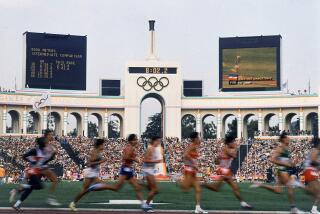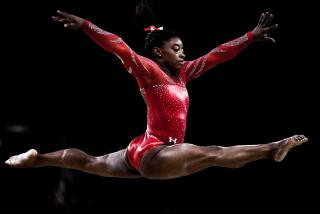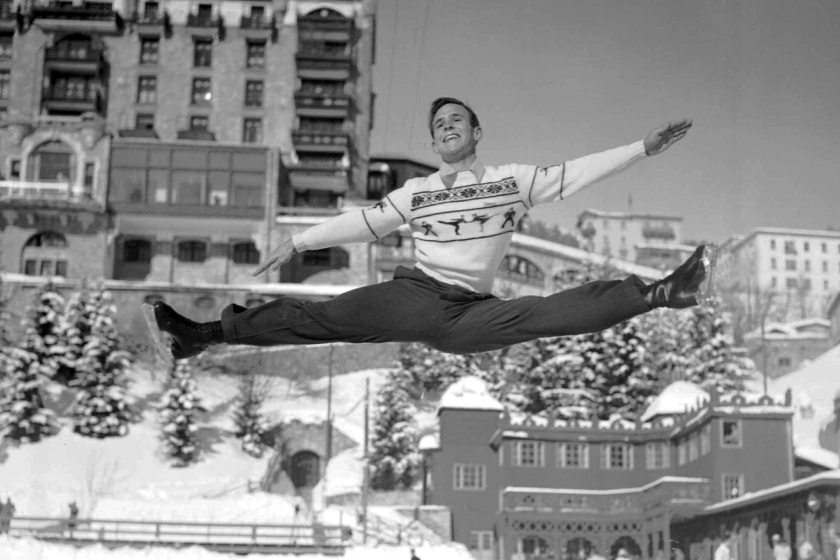THE BEN JOHNSON STEROID INQUIRY : Coach: Johnson Used Steroids Since ’81 : Francis Claims Sprinter Chose to Take Drugs
- Share via
TORONTO — As a track and field athlete, Charlie Francis said during his second day of testimony Wednesday in the Canadian government’s inquiry into international sport, he determined in 1973 that it was impossible to compete at the world-class level without the aid of chemical substances, including anabolic steroids.
But, as a coach nearly a decade later, he said that he felt it was his responsibility to explain the facts, as he understood them, to his athletes and allow them to decide for themselves.
He said that among the first to agree to use banned drugs, in 1981, was a promising young sprinter named Ben Johnson.
“Either he could decide whether he wanted to participate at the highest level of sport or not,” said Francis, who, before completing his fourth hour of riveting testimony Wednesday, named 11 of his athletes as steroid users between 1979 and 1986, including five who won medals at the 1984 Summer Olympics in Los Angeles.
“It was pretty clear that steroids are worth one meter (in the 100 meters) at the highest level of competition. He could decide he wanted to set his starting blocks at the same place as the others. Or he could set them up a meter behind.
“It was pretty clear he wanted to participate. He knew when he was using (drugs) and why.”
Seven years later, at the 1988 Summer Olympics in Seoul, Johnson came crashing down from the sport’s highest level, losing a gold medal and a world record in the 100 meters, after testing positive for an anabolic steroid, stanozolol.
That was one of numerous drugs and other banned substances used through the years by Johnson, his coach of almost 12 years contended under oath during the track and field phase of the hearings, known officially as the Inquiry into the Use of Drugs and Banned Practices Intended to Increase Athletic Performance.
Charles L. Dubin, the Ontario associate chief justice who heads the commission conducting the inquiry, said when the hearings began in November that the goal was to determine the pressures that lead Canadian athletes to cheat and to recommend means by which sport in the country can be returned to its proper perspective.
But it was Johnson’s disqualification that motivated the government to begin the inquiry. And, even in absentia, he has been its central character. He is expected to testify within the next two or three weeks as the commission’s co-counsel, Robert P. Armstrong, summons other athletes, doctors and Canadian and international Olympic officials.
After hearing Francis’ testimony Wednesday, Johnson’s attorney, Ed Futerman, would not comment. Dubin has requested that all the principals and their attorneys refrain from speaking with reporters until the hearings are completed.
“You’ll hear some more tomorrow, won’t you?” was the only comment made to reporters by David Sookram, the attorney for Dr. Jamie Astaphan, as he disappeared into an elevator in the rented office building in downtown Toronto that serves as the commission’s headquarters.
Francis had said that the controversial Astaphan, who has offices in Toronto and the Caribbean island of St. Kitts, began in the fall of 1984 to administer the drug use of Johnson and other Canadian athletes.
Francis is expected to provide further details today, focusing on 1987 and 1988.
Although the first day of Francis’ testimony Tuesday revolved around his personal history as a sprinter for Canada’s Olympic team in 1972 and a coach in his native Toronto since 1976, the first question he was asked by Armstrong Wednesday was about anabolic steroid use in the sport.
Francis, 40, began building a case for his initial decision in 1973--one year before steroids were banned by the International Olympic Committee--to use the drugs himself and for the counseling that he would give years later to the athletes that he coached. Although he did not give names, he implicated athletes, former and current, from eight countries. Many of them were from the United States.
“There are people out there claiming that they (succeeded) clean, that they did it by working hard,” Francis said. “But that’s just not true, not at the highest level.”
But although many of the allegations he made against other athletes were based on hearsay and not specifics, he supplied firsthand information about the use of drugs by his own athletes in dizzying detail.
Interrupting him at one point, Dubin wondered out loud if Francis had actually majored in political science and history at Stanford University, as the coach claimed Tuesday, or pharmacology.
“It seems to me that pharmacology goes along with the sport,” Francis said.
His first athlete to use anabolic steroids, he said, was sprinter Angella Taylor Issajenko in 1979. Francis said that after speaking with coaches around the world and considering the rapid improvement in times in the women’s sprints since 1968, he concluded that Issajenko could not be competitive at the international level without using drugs.
She agreed, he said, and began taking the most popular anabolic steroid of the day, Dianabol, which was prescribed by a physician.
“It was my opinion that they were working,” he said of the drugs. “She was improving dramatically. Her records kept going down and down.”
Asked if he observed any side effects often associated with steroids, he said: “I detected none. She obviously gained muscle.”
Francis said several of his most successful athletes followed Issajenko’s example in subsequent years. The five who won medals in Los Angeles were Johnson, bronzes in the 100 meters and the 400-meter relay; Issajenko, silver in the 400-meter relay; Molly Killingbeck, silver in the 1,600-meter relay; Tony Sharpe, bronze in the 400-meter relay; and Desai Williams, bronze in the 400-meter relay.
He said that he first approached Johnson about using drugs in the fall of 1981 after it had become apparent during a European tour the previous summer that the sprinter had world-class potential.
“We had a discussion about the situation we had seen in Europe and what we were seeing in America,” Francis said. “It became very clear that he was on the threshold of breaking into international prominence. If he was doing the same things his competitors were doing, there was the likelihood that he would be among them.”
Francis said that he arranged for Johnson to see Issajenko’s doctor, who gave him a medical description of anabolic steroids. The doctor, however, no longer could prescribe Dianabol because the pharmaceutical company that manufactured the drug no longer was distributing it. Francis said that Issajenko had been supplied for a year by a Canadian shotputter, Bishop Dolegiewicz. His attorney, Chris Ashby, would not comment Wednesday.
“In the fall of ‘81, leading into the ’82 season, Ben decided he wanted to go on (Dianabol),” Francis said.
He said that Johnson initially took five milligrams a day and later alternated between five and 10 milligrams a day for a nine-week period, in which he was on the drug for three weeks, off for three weeks and back on for three weeks.
“Did Ben Johnson understand that Dianabol was an anabolic steroid?” Armstrong asked.
“Yes,” Francis said.
“Did Ben Johnson understand that anabolic steroids were banned (by the International Olympic Committee and the international track and field federation)?”
“Yes.”
Johnson showed “very good improvement” in 1982, Francis said, but he and the other athletes switched later that year from Dianabol to stanozolol at Dolegiewicz’s suggestion because it was considered a milder drug. But Francis said that the athletes were not satisfied with stanozolol because it made their muscles stiff and returned in 1983 to Dianabol.
In the fall of 1983, Francis said that “a Los Angeles doctor,” prescribed human growth hormone for Issajenko. Human growth hormone is not a synthetic steroid but a naturally produced growth inducer that is taken from human cadavers. It normally is used in the treatment of child dwarfs, but it became popular among athletes in the early ‘80s.
Francis said that Astaphan, who began working with several Canadian athletes in 1983, prescribed human growth hormone in the fall of that year for Johnson, who used it as a complement to Dianabol. Although human growth hormone at the time cost between $130 and $150 a bottle, Francis said that Astaphan provided 14 bottles of it for Johnson and two other athletes at no charge.
Johnson continued to use human growth hormone for six weeks in the spring of 1984, along with a form of testosterone, as he prepared for the 1984 Summer Olympics, Francis said. He said that Johnson received his injections from Issajenko. By then, he had emerged as one of the world’s top sprinters. In Los Angeles, he finished third behind two Americans, Carl Lewis and Sam Graddy.
After the Olympics, Francis said that Astaphan became more involved with the athletes’ drug regimen, taking them off human growth hormone and switching them back to Dianabol, although a milder form than they had originally used.
As Johnson continued to improve, beating Lewis for the first time in 1985 after seven previous losses dating to 1980, Francis said they were not concerned about the drug tests.
He said that on the bottles of Dianabol, Astaphan placed a label that warned: “Do Not Take Within 28 Days of Competition.”
Francis said that Astaphan believed the drug would clear the system in 21 days, but that he advised athletes against taking it for an additional seven days as a precautionary measure.
In the fall of 1985, Francis said, Astaphan again changed his drug of choice, prescribing a steroid known as Furazabol for Johnson and the other athletes. Francis said that Astaphan also prescribed stanozolol for Johnson in the fall of 1985 and the spring of 1986.
Asked by Armstrong if he ever noticed any side effects in Johnson through his first five years of drug use, Francis said, “No, I did not.”
Johnson had his best results to date in 1986, beating Lewis all three times they met and finishing the year ranked first in the world.
“In 1986, the main difference in his performance was that he was much more consistent,” Francis said. “He ran 9.95 (a sea-level record) and indicated to me that he was capable of running a 9.90.”
Johnson set the existing world record of 9.83 at the World Championships in Rome in 1987 and lowered it to 9.79 a year later in Seoul, although that was erased from the record books after he was disqualified.
Contacted Wednesday in Budapest, Hungary, John Holt, secretary general of the International Amateur Athletic Federation, which governs track and field, said that Johnson’s 1987 world record will stand even if he confirms Francis’ allegations.
“There is no way legally we can take the record away from him,” Holt said. “Our English lawyers have gone over this. Obviously, internally, we’ll look at the situation and see. But we’re not going to go into a witch hunt.”
More to Read
Go beyond the scoreboard
Get the latest on L.A.'s teams in the daily Sports Report newsletter.
You may occasionally receive promotional content from the Los Angeles Times.






